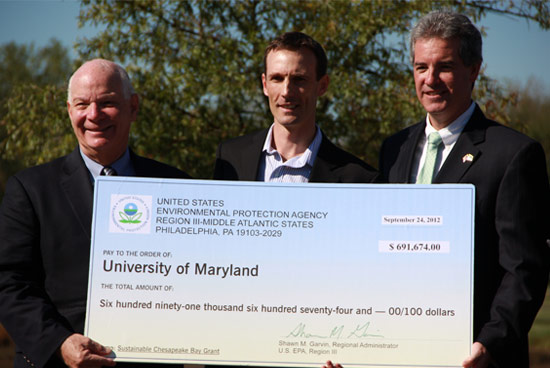University of Maryland receives federal grant to curb stormwater runoff into Chesapeake Bay
Social marketing will boost engagement in two watershed communities.
The University of Maryland has received close to $700,000 in federal funding to help communities reduce stormwater runoff.
Using a software program to pinpoint pollution hot spots and an innovative brand of social marketing to boost citizen engagement, the university will embark on a multi-year project to increase the adoption of conservation practices in two watershed communities: the Wilde Lake watershed in Howard County, Md., and the Watts Branch watershed in Washington, D.C., whose waters flow into the Patuxent and Anacostia rivers, respectively.

Stormwater runoff, or rainfall that picks up pollutants as it flows across paved roads, parking lots, lawns and golf courses, is the fastest growing source of pollution into the Chesapeake Bay. Best management practices can reduce the flow of stormwater into creeks, streams and rivers, from the green roofs that trap and filter stormwater to the permeable pavement that allows stormwater to trickle underground rather than rush into storm drains.
But best management practices cannot work without the citizens who put them into action.
"We need to work with communities, rather than take a top-down approach [to stormwater management]," said project lead and assistant professor Paul Leisnham. "For the long-term successful implementation of these practices ... we need communities to be involved."
The university has partnered with local schools, religious organizations and grassroots associations (among them the Maryland Sea Grant, the Anacostia Watershed Society and Groundwork Anacostia) in hopes of breaking down barriers to the adoption of best management practices and increasing community involvement—and thus, investment—in local, long-term environmental conservation.

From left, U.S. Senator Ben Cardin, University of Maryland assistant professor Paul Leisnham and U.S. EPA Region 3 Administrator Shawn M. Garvin
U.S. Senator Ben Cardin commended the project at a Bladensburg Waterfront Park event as a creative and results-driven way to reduce stormwater runoff.
"It's going to allow us to make a difference in our [local] watershed, which will make a difference in the Chesapeake Bay," Cardin said.
The funding, which totaled $691,674, was awarded through the Sustainable Chesapeake Grant program administered by the U.S. Environmental Protection Agency.

Comments
There are no comments.
Thank you!
Your comment has been received. Before it can be published, the comment will be reviewed by our team to ensure it adheres with our rules of engagement.
Back to recent stories